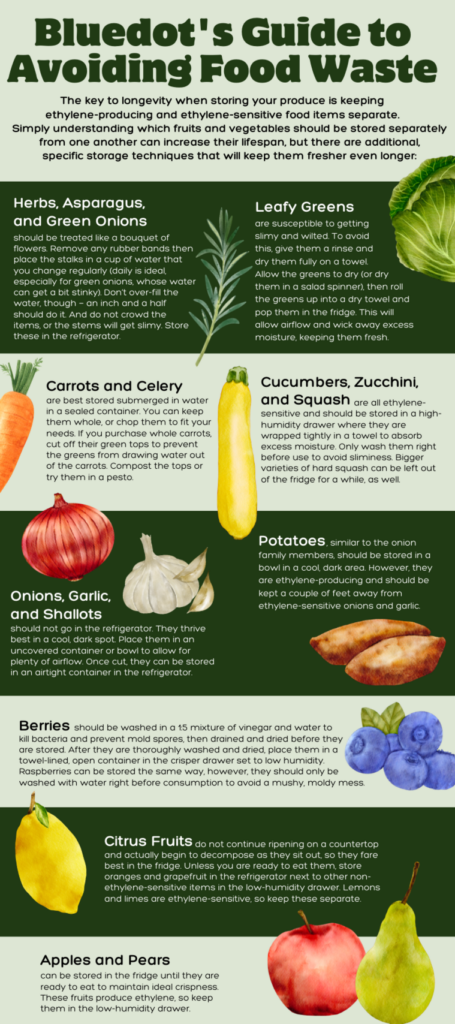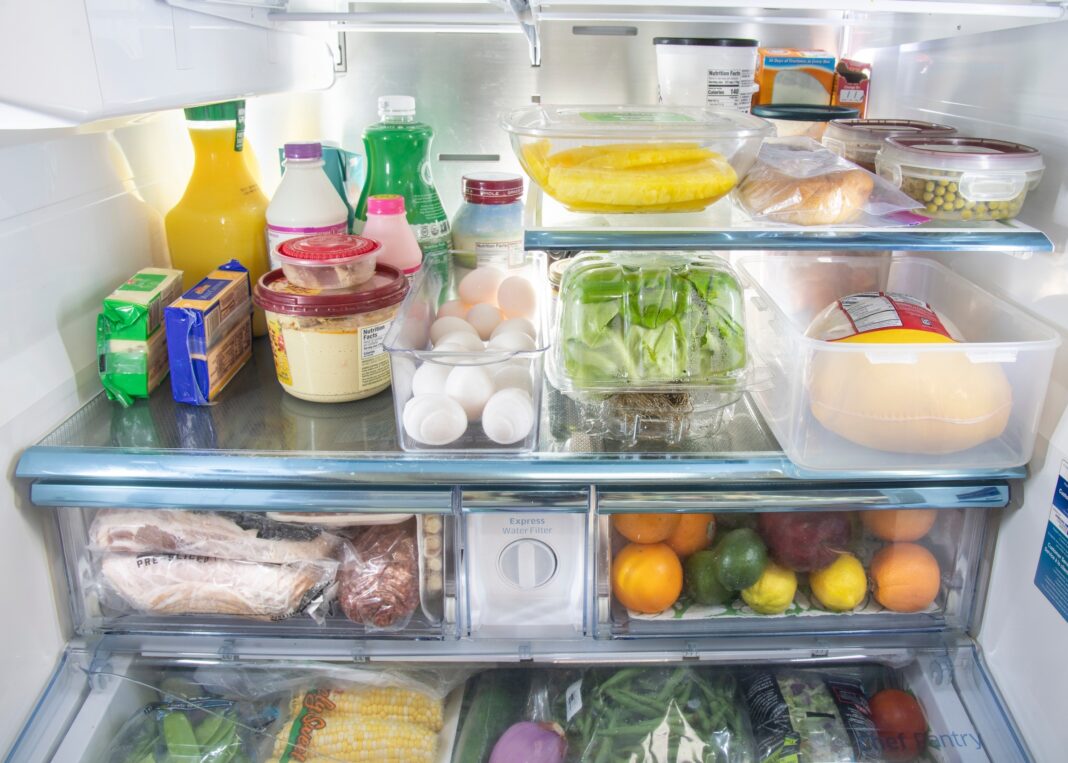Food waste is a pressing issue for the planet that you can help fight from your fridge.
Keeping your groceries fresh for as long as possible is important to maintaining both a balanced budget and a healthy planet. Wilted and moldy produce in your vegetable crisper equals food waste — the unfortunate fate of 40 percent of all food produced in the United States. Food waste not only leads to a higher grocery bill; it also accounts for around ten percent of global carbon emissions.
There are plenty of preventative measures you can take to fight food waste, and here are just a few:
Plan ahead
Before heading out to shop, make a plan. Do some meal planning, taking into account what you might already have on hand, and then shop for only what you need … and want. By laying out a menu before each trip to the grocery store, you can ensure that you buy only what you need and that you eat everything you buy.
You might begin by writing down the ingredients for each dish you want to eat for the upcoming week or two, and use it as a grocery list — making sure to first check your fridge and pantry to avoid buying something you already have. To make this easier in the future, you might start an evolving list of what you have in your kitchen and update it as things are used or new items are purchased. As you curate each week’s menu and explore new recipes, you can also keep track of the recipes your household enjoys for future meal inspiration.
Put scraps and leftovers to use
While you cook and prep your produce for each meal, collect the vegetable scraps and put them to good use rather than letting them go to waste. Onion skins, garlic skins, carrot tops and shavings, the ends of celery, and any other bits of leftover veggies can be collected in a large bag stored in the freezer. Eventually, they can be made into a delicious homemade vegetable broth by simply boiling them with seasonings of your choice. If a scrappy soup isn’t your cup of tea, you can add the leftover scraps to your at-home compost for an equally eco-conscious food waste solution.
If you find yourself with leftovers after a meal, pack them up in clear glass containers. Being able to see through the containers will help you remember what meals you have on hand. This kind of container is also microwave-safe, making it easier to reheat your leftovers for a quick and easy meal. As you pack leftovers up, use a dry-erase marker to label the container with the date that you’re putting them away to keep track of how long the food has been stored.
If leftovers start to take over your refrigerator, consider adding a “leftover day” to your weekly menu. This is a day when there’s no cooking, and you can use up any leftovers in your fridge.
Know who doesn’t get along
The key to longevity and avoiding food waste when storing your produce is keeping ethylene-producing and ethylene-sensitive food items separate. Ethylene gas is a naturally occurring, odorless, hydrocarbon gas. In plants, ethylene acts as a hormone that regulates development and growth, as well as the speed at which they occur. It is emitted from some fruits and vegetables during ripening. The problem is that some produce items (including lettuce, broccoli, carrots, and even some of the ethylene producers themselves) are ethylene-sensitive and will spoil sooner when exposed to this gas.
The key to longevity and avoiding food waste when storing your produce is keeping ethylene-producing and ethylene-sensitive food items separate.
Segregating your ethylene producers from your ethylene-sensitive items will help keep them all fresh longer. Ethylene-sensitive produce should be stored in the crisper drawer set to high humidity. The high-humidity setting will contain any moisture, keeping your ethylene-sensitive goods fresh. Alternatively, ethylene-emitting produce can be kept in a crisper drawer set to low humidity, allowing some moisture and ethylene to escape the space.
Simply understanding which fruits and vegetables should be stored separately from one another can increase their lifespan, but there are additional, specific storage techniques that will keep them fresher even longer.
Proper storage
Herbs, asparagus, and green onions should be treated like a bouquet of flowers: placed in a cup of water that is changed regularly. Store these in the refrigerator.
Carrots and celery are best stored submerged in water in a sealed container. You can keep them whole, or chop them to fit your needs. If you purchase whole carrots, cut off their green tops to prevent the greens from drawing water out of the carrots.

Leafy greens are susceptible to getting slimy and wilted if stored improperly. To avoid this, give them a rinse and let them fully dry on a towel. Once both the greens and the towel are dry, roll the greens up into the towel and pop them in the fridge. This will allow airflow and wick away excess moisture, keeping them fresh.
Cucumbers, zucchini, and squash are all ethylene-sensitive and should be stored in a high-humidity drawer where they are wrapped tightly in a towel to absorb excess moisture. Only wash them right before use to avoid sliminess.
Onions, garlic, and shallots should be stored on the counter, outside of the refrigerator, when they are uncut. They thrive best in a cool, dark spot. Place them in an uncovered container or bowl to allow for plenty of airflow. Once they are cut, they can be stored in an airtight container in the refrigerator.
Potatoes, similar to the onion family members above, should be stored in a bowl in a cool, dark area. However, they are ethylene-producing and should be kept a couple of feet away from ethylene-sensitive onions and garlic.
Berries should be washed in a 1:5 mixture of vinegar and water to kill bacteria and prevent mold spores, drained, and dried before they are stored. After they are thoroughly washed and dried, place them in a towel-lined, open container in the crisper drawer set to low humidity in the refrigerator. Raspberries can be stored the same way, however, they should only be washed with water right before consumption to avoid a mushy, moldy mess.

Citrus fruits do not continue ripening on a countertop and actually begin to decompose as they sit out, so they fare best in the fridge. Unless you are ready to eat them, store oranges and grapefruit in the refrigerator next to other non-ethylene-sensitive items in the low-humidity drawer. Lemons and limes are citrus that are ethylene-sensitive, so keep these separate.
Apples and pears can be stored in the fridge until they are ready to eat to maintain ideal crispness. These fruits produce ethylene, so keep them in the low-humidity drawer.
Best by dates are not a death sentence
There is widespread misunderstanding surrounding the meaning behind “best by,” “use by,” “expiration,” and all the other dates printed on our food. As explained in “What to Know About Food Expiration Dates,” our senses are likely the better judge of when (or when not) to toss out food. So, if your food looks, smells, and feels edible, take a bite and let your tastebuds decide. (Curious about that bulging can? Dear Dot advises.)
The freezer can be your best friend if you’re looking to freeze time on soon-to-be-spoiled food. You can freeze herbs such as basil, cilantro, and parsley, or even freeze broth to preserve freshness for a future soup. Most frozen fruits and vegetables work well in smoothies or soups.
There is widespread misunderstanding surrounding the meaning behind “best by,” “use by,” “expiration,” and all the other dates printed on our food. Our senses are likely the better judge of when (or when not) to toss out food.
Some dairy products freeze surprisingly well and can last months when frozen. Yogurt that you’ve frozen is another great addition to a smoothie and can last for up to two months in the freezer. Shredded cheese can be frozen for up to nine months and taken out to thaw when ready to use. Milk is another item to freeze when you’re in a pinch, just make sure to leave space in the jug before freezing to avoid the expanding milk breaking the container. When dairy products are frozen, fat may separate from liquid once they are thawed. Simply shake or stir to remix them.
Although the freezer can be a saving grace, some food items do not work well when frozen and should instead be eaten when they are near their end. Greens like lettuce lose their crisp texture once frozen, making them a limp and unenjoyable item to eat. This is the case with all foods with a high water content, including cucumbers, zucchini, and tomatoes (though frozen zucchini and tomatoes can be used in soups).
If your freezer is full, you can make the most out of your less-than-best food items with creative recipes. Stale bread is perfect to use for homemade bread crumbs or a refreshing panzanella salad. Overripe bananas can be mashed into pancake batter or baked into a delicious banana bread.
Food waste is a daunting global issue, but rest assured that you can help from home. Implementing these tips and tricks into your kitchen will help reduce your household’s overall food waste, and each meal might taste a little better knowing you’ve made a difference.



